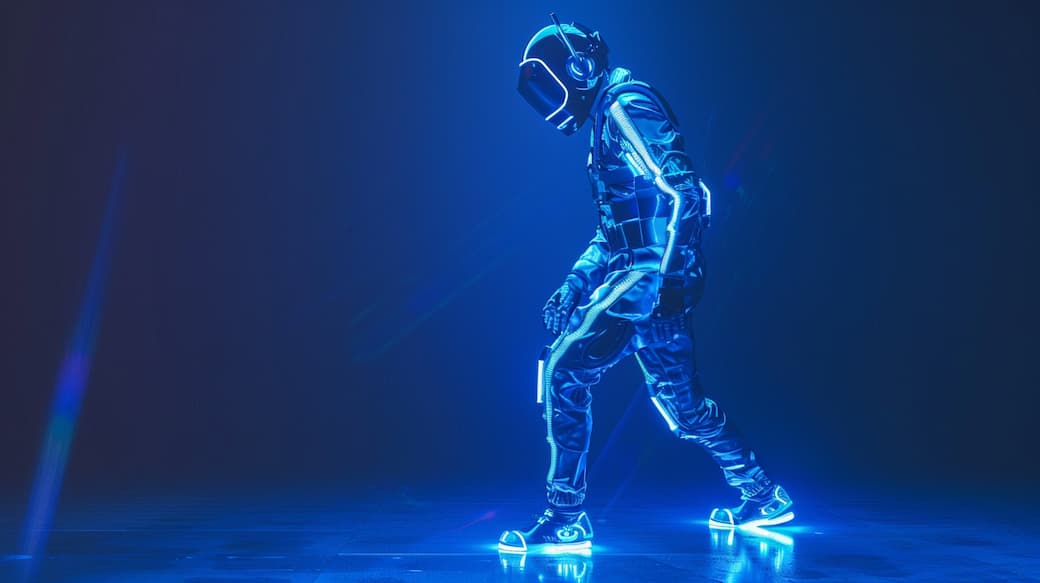
VR Haptic Suits for vibrating sound feeling
Content
Haptic feedback brings Virtual Reality to life, letting you not just see and hear the virtual world, but also feel it. From the subtle brush of wind to the impact of a virtual ball, haptic suits and gloves intensify presence and interaction. This article dives into the top VR haptic suits, gloves, and their real-world applications, providing essential insights for those ready to take their VR journey beyond sight and sound.
Key Takeaways
- Haptic feedback technologies, such as force, vibrotactile, electrotactile, and ultrasonic feedback, play a critical role in enhancing VR immersion, with applications ranging from gaming to medical training.
- Full-body haptic suits like the Teslasuit and other competitors, equipped with EMS, TENS, and other systems, offer realistic tactile experiences across the entire body, elevating the VR experience with touch, pressure, and temperature sensations.
- Haptic gloves, such as the SenseGlove Nova, use sensor-based finger tracking and magnetic friction brakes to simulate realistic touch interactions, enriching the user experience in VR environments.
Disclaimer: This article was generated by AI as a test, feel free to give me feedback
The Power of Haptic Feedback in VR
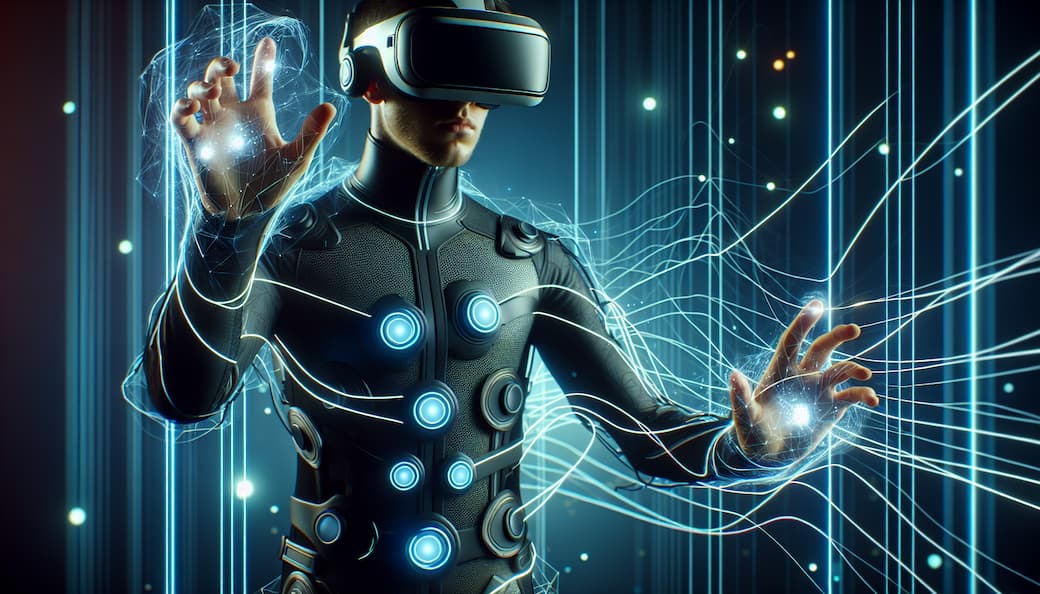
Haptic feedback plays a crucial role in virtual reality by creating realistic sensations and making the VR experience more engaging. It allows users to feel textures, impacts, vibrations, and other interactions within a virtual environment.
Haptic feedback is not only about increasing realism, but also adds depth to interactive experiences such as gaming, healthcare applications, and educational simulations.
There are various types of haptic feedback used in VR technology that each offer unique characteristics for enhancing the overall experience. These include force feedback which simulates physical forces on objects, vibrotactile feedback which produces vibration sensations through small motors or actuators, and electrotactile feedback where electrical signals stimulate nerve endings on skin.
And ultrasonicfeedback using high-frequency sound waves to create pressure variations felt as tactile sensation.
Each type of haptic technology offers distinct details that contribute towards an immersive VR experience like never before seen.Therefore,the use of haptics has revolutionized how we engage with video content from now on.
From now it won’t be just visuals and sounds alone but allow us to have life-like engagement into simulated environments, all thanks to pioneering works being done in this field continuously looking forward to future frontiers accelerating 3D space within cellular devices.
However, this cutting-edge implementation requires significant advancement integrating engineering materials meant best understanding human kinesthesia contrasted against already existent mechanical gear attached powerful hi-tech including vibes world open-experiments.
The Science Behind Haptic Feedback
Unraveling the science behind haptic feedback is key to understanding its role in enhancing VR. Haptic feedback, also known as haptics, uses regulated vibrations or physical stimuli, such as vibration patterns, to replicate tactile sensations. This technology is an incredible feat of engineering, combining the principles of physics, electronics, and software engineering to simulate the feel of the real world in VR.
Haptic feedback significantly influences VR. It enhances immersion, improves learning outcomes, and fosters a deeper connection to the virtual environment, creating a stronger sense of presence and realism.
For instance, by allowing users to physically engage with virtual objects and perceive feedback, haptic feedback stimulates their imagination and heightens their sense of presence in the virtual environment created by the VR system.
Applications of Haptic Feedback in VR
Haptic feedback is a technology widely utilized in various domains of virtual reality. In the world of gaming, it allows players to experience tactile sensations like vibrations, resulting in a more immersive and realistic gameplay. Its applications go beyond entertainment.
In VR training scenarios, haptic feedback greatly enhances the sense of immersion by providing lifelike responses to movements and actions such as simulating resistance or vibrations. This can significantly improve motor skills, hand-eye coordination and spatial awareness for trainees.
For instance, in medical simulations where precision is crucial,haptics enable precise manipulation of instruments which reduces the risks associated with actual patient interaction.Additionally, the safe learning environment provided through repetitive practice enables trainees to perfect their techniques without causing harm.
Full Body Haptic Suits: Revolutionizing Virtual Reality

Moving deeper into the world of full-body haptic suits, we will delve into their use of electro muscle stimulation (EMS) and transcutaneous electrical nerve stimulation (TENS). These advanced technologies are used to recreate realistic sensations and experiences for users.
By incorporating haptic feedback, these suits allow individuals to feel physical responses such as touch, pressure, vibration, and changes in temperature – thus enhancing the overall virtual reality (VR) experience.
One notable leader in this field is the Teslasuit, which boasts a sensory-based system that delivers both tactile feedback and motion capture capabilities. Equipped with a climate control feature. Its electro-tactile technology generates lifelike forces throughout one’s entire body providing an unmatched immersive experience. There are other competitors making waves like bHaptics.
Overall, it is clear that there is intense competition among companies producing full body haptic suit solutions designed to enhance VR immersion by replicating real-life sensations through methods including EMS and TENS.The top player, Teslasuit offers impressive features, but it faces stiff competition from emerging alternatives such as bHaptics- all geared towards offering game-changing bodily interactions within highly engaging VR environments.
Teslasuit: A Leader in Full Body Haptic Suits
When examining the Teslasuit, haptic feedback is a notable feature that sets it apart. This function allows for realistic sensations to be experienced within the virtual environment and enhances touch perception.
The suit employs electro muscle stimulation (EMS) and transcutaneous electrical nerve stimulation (TENS) in order to deliver this haptic feedback, providing users with a more immersive VR experience where they can interact with objects and heighten their sensory awareness.
Not only does the Teslasuit have impressive haptic capabilities, but it also offers compatibility with established VR headsets like Oculus Rift as well as popular platforms including Unity 3D, Unreal Engine, MotionBuilder, Windows, Android, iOS, and Xbox.
This wide range of usability makes it an incredibly versatile option for both developers and those looking for a fully engaging VR experience.
Other Notable Full Body Haptic Suits
When it comes to full-body haptic suits, the Teslasuit may be leading the market, but there are other players in this game. The HaptX suit boasts a magnetic motion capture system with precise hand movements and zero delay. It also uses pneumatic actuators for powerful feedback.
Competing against these is the bHaptics Tactsuit X40, which offers accurate directional capabilities, making it suitable for VR experiences like Onward and Sniper Elite VR. With 40 ERM vibration motors and long battery life, this suit delivers realistic haptic sensations.
The Hardlight or Nullspace VR suit has also been highly praised for its authentic haptic feedback that enhances immersion during virtual reality experiences.
While Tesla’s offering may seem top-notch, alternative options such as HaptX or bHapitcs offer equally impressive features when it comes to delivering an immersive experience through advanced motion capture technology and forceful vibrations generated by specialized wireless actuators.
As more companies enter into this exciting arena of body-hugging tech wearables designed specifically for enhanced virtual interactions, the competition can only intensify Driving innovation at an unprecedented level!
Haptic Gloves: Enhancing Hand Interactions in VR
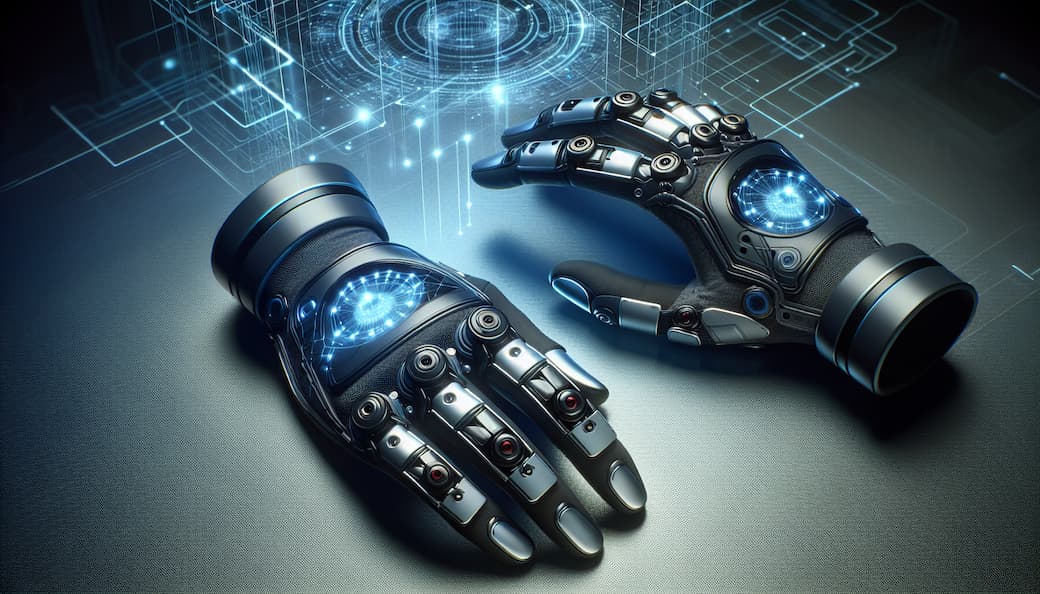
Next, let’s focus on haptic gloves for VR. These specialized gloves offer tactile feedback and allow users to interact with virtual objects using hand gestures, greatly enhancing the VR experience.
One exceptional example of advanced haptic VR glove is the SenseGlove Nova, featuring magnetic friction brakes and vibrotactile technology that replicate realistic sensations in simulations. It also utilizes computer vision-based finger tracking through 4 sensors to accurately capture hand movements.
With its flexible design providing a lifelike touch sensation and wireless compatibility with lightweight standalone headsets, this compact glove certainly stands out among others in its category.
SenseGlove Nova: Advanced Haptic VR Gloves
The SenseGlove Nova is equipped with advanced features including biometric sensors for finger location tracking, computer vision hand tracking algorithms, and four sensors to accurately capture finger movements. With each brake capable of delivering up to 20N of force and a completely wireless design, this device offers an unparalleled haptic experience in virtual reality (VR).
Its integration of force feedback, vibrotactile feedback and motion tracking creates a truly immersive sensation within the user’s hands while using VR technology. Not only does it provide haptic feedback but also enhances it with active skin contact simulation for added realism.
The SenseGlove Nova is compatible with both standalone headsets as well as base station tracked ones, expanding its range of usability options.
Comparing Haptic Gloves: Manus Prime X vs. Weart TouchDIVER
When it comes to choosing the right haptic gloves, there are numerous options available in the market. Two prominent contenders are Manus Prime X and Weart TouchDIVER. The standout feature of Manus Prime X is its low signal latency of under 5ms, high sensor sample rate of 90Hz, and long battery life lasting up to 5 hours.
These qualities make them a preferred choice for providing accurate haptic feedback that enhances virtual interactions.
On the other hand, Weart’s TouchDIVER gloves excel in delivering three distinct touch sensations – force feedback, textures, and thermal cues, all on one fingertip. Users reviews have highly praised Manus Prime X Haptic VR gloves for their precise haptic feedback which makes virtual interactions feel more lifelike while personal reviews have acknowledged Weart’s TouchDIVER gloves for their ability to deliver multiple types of tactile sensations effectively.
VR Headsets: The Gateway to Immersive Worlds
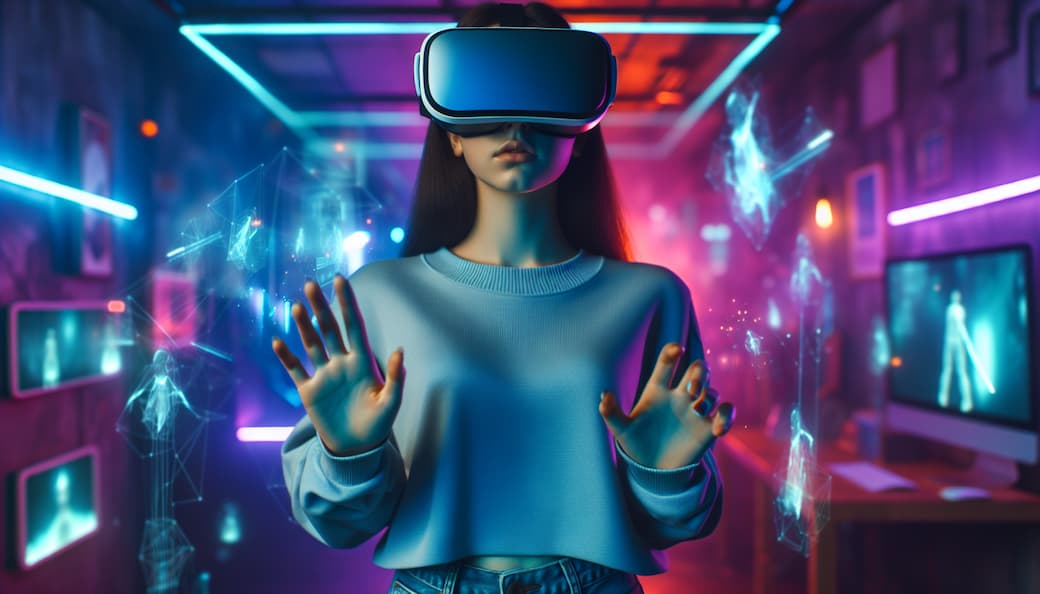
The role of VR headsets cannot be underestimated as they serve as the gateway to our immersive virtual world. Among the popular choices is the Oculus Quest 2, offering features such as positional audio, dynamic controllers, hand tracking and 6DOF tracking that enhance user experience for diverse interests like gaming, fitness, music, and virtual theater.
Apart from Oculus Quest 2, other significant VR headsets in this industry include Meta Quest 3, HTC Vive XR Elite and Meta Quest Pro. The manufacturers – namely Meta quest, Sony, Valve HP & HTC – are constantly innovating to provide top-notch immersive experiences for their users.
Oculus Quest 2: A Popular Choice
The Oculus Quest 2 VR headset stands out for its positional audio, dynamic controllers, hand-tracking, and a 3.5 mm audio port. The headset’s popularity can be attributed to its wireless VR capability, ability to deliver new experiences, opportunities for development, and its role in making VR more accessible and popular by removing barriers to entry.
Apart from its superior capabilities, the Oculus Quest 2 also boasts several enhancements over its predecessor, such as:
- A faster processor
- Superior display
- Increased RAM
- Enhanced controllers
- Reduced weight
- Improved design
And at a price of $299.99 USD for the 128GB SKU, it presents itself as a cost-effective choice for individuals seeking to immerse themselves in high-caliber VR experiences.
Other VR Headsets Worth Considering
Aside from the Oculus Quest 2, there are other VR headsets worth considering. For instance, the HTC Vive Pro has improved features such as a better headtrap and certified Hi-Res built-in headphones compared to its predecessor.
To the Valve Index, which offers superior audio and a wider field of view, it falls slightly behind.
The Sony PlayStation VR provides an immersive headset with 360-degree vision for a seamless viewing experience. Its advanced processing power supports realistic graphics that enhance the virtual reality immersion.
Another highly regarded option is the Samsung Odyssey VR headset known for its exceptional visual quality thanks to its high-resolution display sets it apart from other available options on market shelves.
Customizing Your VR Experience: Tips for Choosing the Right Haptic Devices
Choosing the right haptic devices is a crucial aspect in personalizing your virtual reality (VR) experience. Some key factors to consider when selecting a VR haptic device include:
- The level and complexity of the haptic feedback provided
- The precision and detail of such tactile responses
- How hardware latency may affect one’s perception of these sensations
- The overall quality, compatibility, cost, and comfortability of the chosen device.
The price range for VR haptic devices can significantly impact the total expenses involved in setting up a VR system. As there are various options available on the market ranging from approximately $100 to thousands of dollars each, it is essential to carefully factor this expense into budgeting for an entire VR setup, especially compared with other costly components like Oculus Rift headsets.
Assessing Your Needs
Before purchasing haptic devices, it is essential to assess your personal needs and preferences. Different types of haptic devices may be more suitable for achieving specific goals in virtual reality (VR) experiences. For example, a full body haptic suit can greatly enhance immersion by providing realistic vibro-tactile sensations throughout the body.
Alternatively, if you are looking to improve hand interactions in VR, incorporating haptic gloves into your setup can offer a greater sense of touch and contact within virtual environments. This enhances overall sensory feedback and improves immersion during gameplay or other activities involving physical movement.
Balancing Performance and Price
Finding the right balance between performance and cost is crucial when purchasing a VR haptic device. The price of these devices depends on various factors such as development expenses, material costs, patent and licensing fees, and the increasing demand for technology fueled by the rise in IoT devices. Depending on your budget and desired level of performance, basic haptic gloves can range from $50 to $250.
The pricing of VR haptic devices takes into account different elements that contribute to their overall quality. High-end options tend to provide more realistic feedback compared to cheaper alternatives due to better materials used in manufacturing them. It’s worth noting that even lower-fidelity sensations can enhance one’s experience during specific tasks if accompanied by suitable audio cues.
Carefully considering features and quality against cost is key when making a decision about which VR haptic device suits your needs best.With prices ranging from affordable ($50) to high-end ($250), weighing all aspects related including materials used,potential patents,and developing costs, the significant growth within the Internet Of Things increases popularizing this area.Newer or lesser fidelity shocks,audio supportive signals combined,to improved tactile senses even at diluted levels.
Real-World Applications of VR Haptic Technology
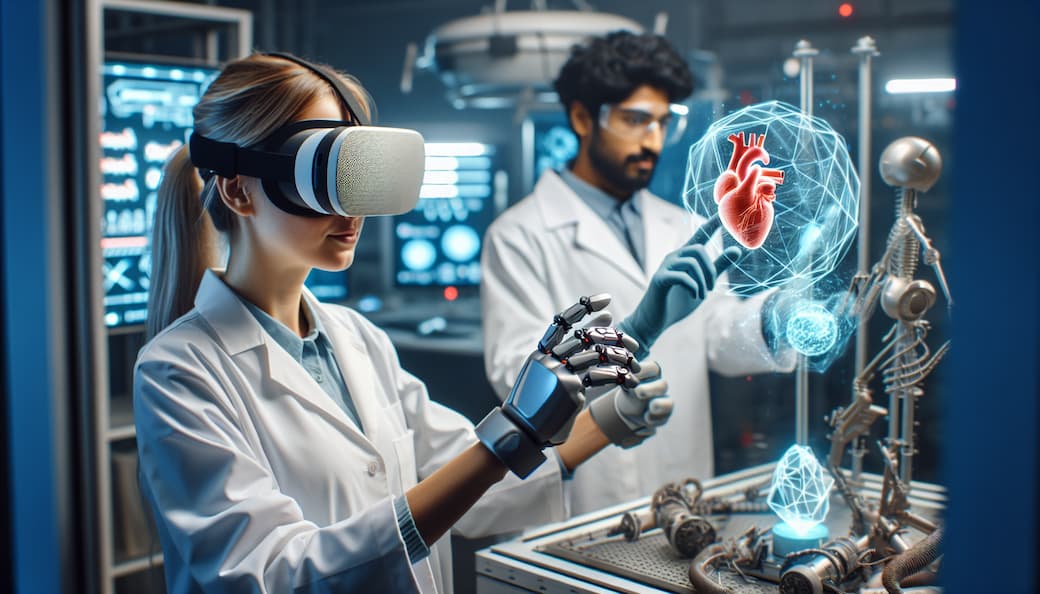
The use of VR haptic technology is not limited to gaming and entertainment, as it has expanded into various practical business fields. In the aerospace sector, for example, XR training is utilized in multiple areas including pilot and ground crew training, design processes, manufacturing procedures, and maintenance protocols. Similarly, in the automotive industry, virtual reality (VR) with haptic feedback improves training quality by allowing operators to refine their driving skills within a simulated environment.
In terms of leisure activities such as gaming, and other forms of entertainment, the incorporation of VR haptic technology greatly enhances the user experience through its ability to create an immersive feeling for virtual actions.This allows players to realistically sense the impact of their movements in virtual worlds.Genres like horror games, such as Phasmophobia, or tactical shooters like Onward and Pavlov, benefit greatly from this form of play.
XR Training in Various Industries
XR training is widely used in various industries, including aerospace and automotive. In the aerospace and defense sector, XR training improves skills practice by providing a safer and more regulated virtual environment for pilots, ground crew members, designers, and maintenance personnel.
The automotive industry utilizes XR training to enhance the quality and effectiveness of their workforce’s driving abilities through simulations in a virtual setting. Additionally, it aids car dealerships’ employees and manufacturing staff to improve their skills effectively.
In medicine,haptic technology plays an essential role in aiding XR training by replicating different textures,sensors, and forces.This enables realistic data-based simulations that are crucial for medical professionals’ skill development.
Entertainment and Gaming
In entertainment and gaming, VR haptic technology serves a crucial function in improving user experience. By offering tactile feedback, it enables players to physically perceive the effects of in-game actions, thereby enhancing immersion and interaction in VR games.
Well-known games such as A Way Out, Cyberpunk 2077, Horizon, and Resident Evil 4 make use of haptic technology, while upcoming VR experiences in games like Attack on Titan VR: Unbreakable and Assassin’s Creed Nexus VR also incorporate this technology to enhance the sense of immersion for players.
Beyond gaming, haptic technology is employed in VR entertainment to augment immersion through the provision of real-time tactile sensations, enabling users to experience a genuine sense of touching and interacting with virtual objects.
Summary
VR haptic technology is changing the way virtual environments are experienced. This advanced technology, whether through a full-body haptic suit or VR gloves and headset, enhances immersion by providing realistic sensory feedback during interactions in VR. As we move forward into the future, it’s clear that this type of haptic technology will continue to be an important aspect of shaping various industries such as gaming and entertainment or XR training with its integration into different forms including full body suits.
Frequently Asked Questions
What is a haptic in VR?
Haptic feedback, a feature of virtual reality, allows the user to experience simulated physical sensations in the digital realm. This enables them to interact with and touch objects within this environment that are not physically present in the real world.
Do VR haptic suits exist?
Indeed, haptic suits for VR are available in the market. These special clothing items such as Teslasuits employ electro-tactile technology to provide realistic sensations while engaging with augmented or virtual reality environments.
Can you feel pain in a VR haptic suit?
A haptic suit for virtual reality has the ability to replicate various types of mild and extreme sensations, including gusts of wind or being stabbed. This allows users to experience different levels of pain and tactile feelings while wearing the suit in a VR environment.
How does a full-body haptic suit work in VR?
A VR suit that covers the entire body utilizes electro muscle stimulation (EMS) and transcutaneous electrical nerve stimulation (TENS) to imitate real-life physical sensations. This is achieved by stimulating muscles and nerves in the body through electronic means, creating a fully immersive experience for users.
What are the features of the Teslasuit?
The Teslasuit boasts a full-body immersive experience with its advanced haptic feedback, motion capture system, and climate control feature. Its sensory-based technology allows for realistic sensations while the motion tracking ensures accurate movement replication. Users can adjust their surrounding temperature through the haptic suit’s built-in climate control system.
Back to the BlogRelated Articles
Immersive Meditation: Mindfulness and Relaxation with Immersion
Sound Haptics: Feel Immersive Tactile Audio Feedback
VRTonung learning - THE spatial audio course for immersive media
Martin Rieger, 3D Audio expert committing his life to immersive experience
Best VR Content highlighting VR-Sound (free) for Oculus Go, Quest